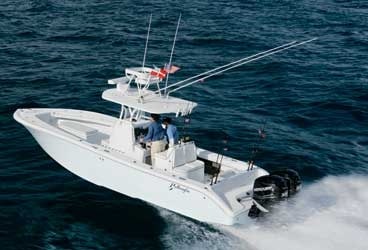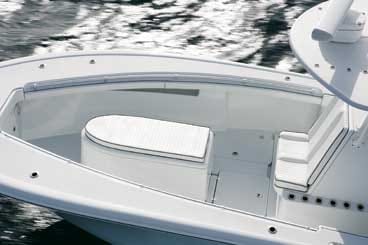
Although some of my die-hard friends fishing the king-mackerel circuit might disagree, speed isn’t the only attribute to consider when it comes to center-console performance. Sure, there are times when you need to go lickety-split – like when a monster lightning storm is bearing down or that monster in the fish bag happens to be 100 miles from the weigh scales. Whenever that happens, it’s comforting to know that you can put the hammer down and go. But there are other factors to consider. Range, rough-water handling, livewell capacity and a functional layout are important too.
Wylie Nagler, president of Yellowfin Yachts, understands the run-and-gun mentality very well, because he raced boats before launching his semicustom line of center consoles in 2000. After retiring the original 31-foot mold, he recently introduced a suitable replacement. The 32 Center Console, like its predecessor, is one sleek, serious fishing machine. And oh yeah, it’s fast too.
The majority of Yellowfins are rigged with Mercury Verado power, although other engine packages are also available. Factory tests of the 32 with a pair of Verado 300 outboards produced a top speed of 60.9 miles per hour at 6,050 rpm. The fuel rate was 59.8 gallons per hour with two people and 175 gallons of gas on board. During my follow-up run with Nagler on his home waters of Sarasota, Florida, our test boat had a pair of Yamaha F350 V-8s hanging off the transom. With the extra 100 horsepower, speed increased to 65.6 miles per hour at 6,100 rpm. The fuel rate was 68.4 gallons per hour. By slowing down to an effortless cruising pace of 4,000 rpm, the boat ran 41 miles per hour while burning only 24.8 gallons per hour. Nagler says he can bump the speed by a few more miles by tweaking the propellers to offset the factory engine rev limits. I don’t doubt it. This craft is made to run.
Starting with a sharp bow entry, the hull transitions aft to the dual, notched steps that serve to ventilate the running surface and reduce drag. Deadrise at the stepped transom is an aggressive 22 degrees. At a stable 9’9″ overall, the beam is nearly 5 inches wider at the stern than the previous model, making the added weight of the four-strokes a nonissue. With two of us leaning over the side, the waterline barely budged. Even so, the aft freeboard isn’t so high that wiring a fish would be a problem. Conversely, the bow cap was lowered slightly to better accommodate “height-challenged” anglers.

Driving the 32 is like driving a Corvette convertible. There’s no hesitation upon initial acceleration, and the bow settles quickly so visibility isn’t hampered. It responds well to the slightest course correction and the oversize K-Plane trim tabs allow rapid adjustment to various loads or sea states. Residual swells from a far-off hurricane provided a good indication of the 32’s sea-keeping abilities. It punched through the waves effortlessly and shed water like a seal. Bottom line – driving this boat will bring out your inner speed demon.
I love a clean, functional layout, and the 32 didn’t disappoint in this department either. From its low-profile bow rail to the flush-mount hardware and the infused nonskid, it offers 360 degrees of unhindered maneuverability when that big smoker is doing doughnuts just beyond the gaff. The dry box in the bow centerline deck can be divided into two sections, and it’s big enough to accommodate beanbags. Two more dry boxes are located in the forward deck. Under the bow covering boards, a recessed shelf, neatly concealed behind a mesh cover, can rack life jackets or other gear.
The large console on the 32 comes standard with a T-top and overhead electronics box; an upgrade to a hardtop is an available option. In fact, since each Yellowfin is sold factory direct, owners can choose a wide variety of add-ons to further customize the boat to meet individual needs. The boat I tested had a pair of 15-inch Northstar displays flush-mounted on the helm with room to spare.
Want a bow coffin box or forward seating? No problem. Boost fuel capacity by 100 gallons for greater range, add a head inside the console or pick one of five leaning-post configurations when you place your order. Nagler sells packages (boat, motors and trailer), and his team is quite capable of adding custom features. A quick look at the wiring harnesses, rigging or overall fit and finish are more indicators of the skill level and professionalism of the Yellowfin crew.
The 32 does come standard with twin livewells, including a 100-gallon pressurized tank incorporated into the leaning post and another 50-gallon tank in the transom. Twin saddle fish boxes with 600-quarts-plus capacity each are housed in the cockpit deck. Different tackle centers are available depending on the leaning-post selection. There’s even a built-in garbage can, so you never have to worry about where to stash the trash.
Like the other six models in the lineup (with a new 29 CC in the works), the 32 is solidly built and uniquely tailored for its owner. However, all share a propensity for speed and performance. Wylie Nagler wouldn’t have it any other way.
Yellowfin 32
LOA……32’6″
BEAM……9’9″
DRAFT……1’6″
DEADRISE……22°
Weight……8,500 LBS. dry
MAX. HP……700
WATER……65 gals.
FUEL……225 gals.
PRICE……$157,000
w/twin Mercury 300 hp Verado Four-Strokes and Trailer
Yellowfin Yachts ? 941.753.7828 ? www.yellowfinyachts.com









